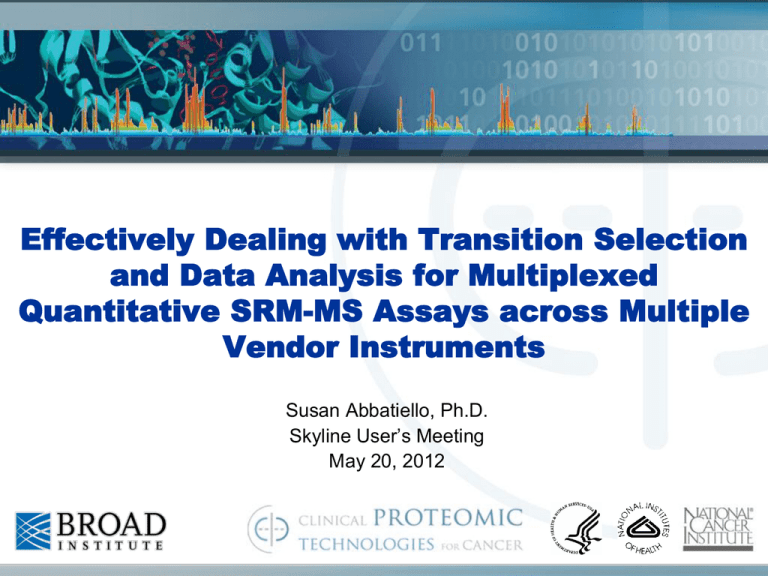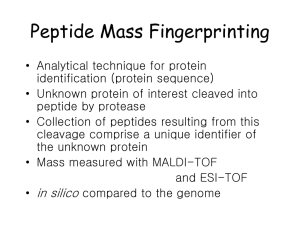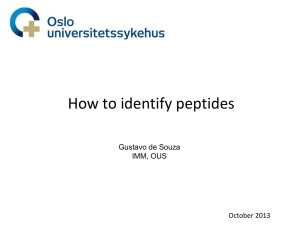
Effectively Dealing with Transition Selection
and Data Analysis for Multiplexed
Quantitative SRM-MS Assays across Multiple
Vendor Instruments
Susan Abbatiello, Ph.D.
Skyline User’s Meeting
May 20, 2012
CPTAC – Clinical Proteomic Technologies
Assessment for Cancer
NCI established CPTAC October 2006 to Support Biomarker Development
• Evaluate and standardize proteomic verification
platforms for analysis of cancer-relevant proteomic
changes in human clinical specimens.
Is SID-MRM-MS Technology Reproducible, Transferrable,
and Sensitive? Yes! – Especially with Skyline!
Candidate Protein
Biomarkers
Spike heavy (13C6)labeled peptides
Endogenous 12C
signature peptides
Define “Signature peptides”
for candidate biomarkers
MRM-MS
Synthesize 13C/15N-labeled
versions of signature peptides
for use as internal standards
• Observed ratio gives precise, relative
quantitation across samples
• 10’s to 100’s peptides can be
simultaneously quantified
Ratio 13C-peptide to 12Cpeptide by SID-MRM-MS
Abundance
Whiteaker, et al, JPR 2007……………….Breast cancer
Keshishian et al, MCP, 2007 and 2009….Cardiovascular markers
Hoofnagle et al, Clin. Chem. 2008……….Thyroglobulin
Addona et al, Nat. Biotech. 2009…...……Interlab study
Kuhn et al, Clin Chem 2009………………IL-33, Troponin I
Williams et al, JPR 2009…………………C-Reactive Protein
Ossola et al, Methods Mol. Bio., 2011…..Glycated peptides
Selevsek et al, Proteomics, 2011………..Urine proteins
13C
6-peptide
12C-peptide
Time, minutes
“heavy standard”
analyte
Study 9S: Participants, Platforms, and Objectives
Prior to analyzing complex samples, are LC-MRM-MS systems running in optimal condition?
Site 52, ABI 4000 QTRAP
Michrom Mix
6 bovine
proteins,
digested
Establish Instrument
Specific Ranges for
Site 56, ABI 4000 QTRAP
Site 56A, ABI 5500
o RT Variability
Site 56B, Agilent 6460 ChipCube
Site 73, ABI 4000 QTRAP
Site 32, ABI 4000 QTRAP
o Peak Area
Site 95, ABI 4000 QTRAP
o Carry over
Site 98, ABI 4000 QTRAP
o Column conditioning
o Peak Width
Site 86, ABI 4000 QTRAP
Site 86A, Waters Xevo
50 fmol/uL
Site 90, Agilent 6410 ChipCube
Site 65, Thermo Vantage
GO
No GO
Site 54, ABI 4000 QTRAP
12 Laboratories
4 MS Vendors
7 MS models
5 LC models
Site 19, ABI 4000 QTRAP
Site 19A, Agilent 6410 ChipCube
Site 20, Thermo TSQ Quantum
Define Pass/Fail Criteria
Development of a System Suitability Protocol for
Multiple Instrument Platforms
Tools were created to handle workflow and data
Input: DDA Search
results
Selection of
22 target
peptides
(mzXML, pepXML, etc)
List of 9 final
peptides for
evaluation
Output: Spectral Library
Input: Targeted
Peptide List
Input: Integrated
peaks, report
parameters
Output: Vendor
Specific MRM
Instrument Method
Output:
Comprehensive
results report
MRM data
acquisition
Input: Vendor specific
acquisition files
Output: Peak
identification and
automatic integration
User
data
analysis
External
Calculations:
RT Viewer
R Scripts
Problems Can Be Visualized Early:
Peak Area Stability in Skyline
Peak area stability over 10 replicates
Site Z
Peak area CV over 10 replicates
Site Z
before
after
Peak Area CV
Low peak area
for late eluting peptides
Improved peak area
for late eluting peptides
0.3
after
after
Peak Area CV
Peak Area (10E6)
Peak Area (10E6)
before
Elevated area cv’s for late
eluting peptides
CVs < 0.10
CPTAC VWG Study 9 – Targeting 34 Proteins in
Depleted Plasma, 125 Peptide Targets
unlabeled
protein
15N
labeled
protein
Trypsin
+
27 proteins
depleted plasma
34 proteins
13C/15N
Goals:
Varying
Fixed Spike Level
labeled
•Concentrations
Demonstrate cancer relevancy
peptides
• Prove feasibility of > 100-plex (34 proteins) assays in plasma
• Improve LOD and LOQ by depleting abundant proteins
• Demonstrate true quantitative accuracy and evaluate depletion/digestion
125 peptides
y6
y7 using
y8heavy labeled proteins
recovery
y6
y7
y8
Figures of Merit (LOD, LOQ)
Fixed Spike
• Conduct blinded verification study to assess accuracy, precision and
Level
reproducibility across multiple sites and instrument platforms
• Evaluate system suitability test in context of this large-scale inter-lab study
y6
y7
y8
34
proteins,
1095
Recovery from Assay
transitions, 9 participating sites,LC-MRM-MS
14 instruments, 4
Peptide and Transition Selection is
Streamlined using Skyline
Lys-C/Trypsin
+
Selection
of
123 target
peptides
Top 5 Product Ions
Spectral Library
DDA
LC-MS/MS,
Database
search
Final Transition List
L/H: 750 Transitions
L/H/15N: 1095 Transitions
MRM-MS Data Acquisition
• Selection of best 3 ions
• CE Calculation
CE publication: B. MacLean et al, 2010, Anal Chem
Spectral Libraries Focus Peptide and
Transition Selection
Retention Time Scheduling:
A Necessity for >100 Transitions
Scheduling puts rigorous
demands on RT reproducibility
Peak width and RT drift are
often limiting factors
28.3 min
Inj. 1
28.2 min
Inj. 2
28.0 min
Inj. 3
# Concurrent Transitions
Different peptides shift to
various degrees.
10 min
5 min
2 min
325 trs
Large numbers of transitions
require narrow RT windows or
longer cycle times
190 trs
Cycle times may be governed
by chromatographic peak
width
80 trs
Skyline helps gauge number
of concurrent transitions
based on RT window
Retention Time Scheduling for 1095 Transitions is
Challenging – and Different from System to System
Agilent 6490 ChipCube
AB Sciex 4000 QTrap
Data Quality Filtering and Custom Annotation by
Operators for Data Sets Improves LOD
raw data
custom
annotation
Automated version = “AuDIT”
Flags potentially bad transitions
•
poor peak shape
•
interferences
•
missing data
Reduces manual inspection to
questionable data
Reduces subjectivity in data analysis
(Abbatiello, Mani et al. Clin. Chem. 2010)
44 amol/uL
23 amol/uL
Automatic Integration as Good as Manual
Intervention (but takes less time)
p = 0.6
QuaSAR Overview:
Quantitative Statistical Analysis of Reaction Monitoring Results
Pre-process
& Filter
Overall Reproducibility
Concentration
& sample info
Poster ThP12, #284
Outcome of CPTAC Study 9 is Promising for the Use
of Highly Multiplexed SID-MRM-MS Assays
Median CV at each Concentration,
Study 9.1
LOD Distribution for all peptides across
Sites, Study 9.1
1
2
3
4
5
6
7
8
9
Site Number
10
11 12
13
14
1
1
2
2
3
4
5
3
4
5
6
6
7
8
7
8
9
9
10
11
12
10
11
12
13
13
14
14
0
0.001
0.010 0.018 0.075
0.32
1.3
5.6
Concentration of each peptide
(fmol/mL in 0.5 mg/mL depleted plasma)
24
100
Good Reproducibility and Accuracy is
Demonstrated Through Blinded Samples
Blinded Sample %CV Distribution
Blinded Sample Concentration Distribution
Inter-Lab
CV
45%
17%
15%
16%
72 fmol/mL
19 fmol/mL
1.8 fmol/mL
0.1 fmol/mL
1
2
3
4
5
6
7
8
Site
9
10
11 12
13
14
1
2
3
4
5
6
7
8
Site
9
10
11
12
13
14
15N
Protein Standards Improve
Quantitative Accuracy
13C/15N
15N
Peptide Internal
Standards
Protein Internal
Standards
Light Peak Area 25 fmol
Peptide
x
=
Conc(15N) 15N Peak Area
mL
Peptide
Light Peak Area 10 fmol
=
x
Conc(13C/15N)
13C/15N Peak Area
mL
B
A
1.3 fmol/mL
concentration point
Transition
y5
y6
y8
% Recovery
55
57
50
1.3 fmol/mL
concentration point
Transition
y5
y6
y8
% Recovery
110
111
94
Protein Digestion Controls Help
Gauge Assay Variability
Control Proteins
# Peptide
Targets
Aprotinin
1
C-reactive protein
2
Horseradish peroxidase
1
Leptin
1
Myelin basic protein
2
Myoglobin
1
Prostate specific antigen
2
Technical and Process Variability Assessed From
Digestion Controls and SIS Peptide Spikes
Process Variability:
Light Peak Area from Protein
Digestion Controls
Technical Variability:
Peak Area from postdesalt peptide spikes
13C/15N
Poster MP01, #004
Skyline Facilitates Rapid Data Analysis Through
Overview Plots
Peak Area Replicate View, Light and Heavy
Peak Area CV Plots Provide Quick Assessment of
Reproducibility Across a Series of Samples
Retention Time Reproducibility Plots
Show Trends in Retention Time
Quick View of All Replicates
Interference Visualization
Heavy Peptide
Transitions
Light Peptide
Transitions
Summary
• First large-scale interlab study to include 15N protein reagents
and >100 peptide targets (>350 peptide forms)
• Sensitivity improvement from previous study by using depleted
plasma, adjusting the gradient
• Transition selection and MS method transfer across 4 instrument
platforms facilitated through Skyline
• Peak Area and Retention Time views help quickly assess data
quality
• Customizable reports from Skyline enable down-stream
processing, helps remove subjectivity of data evaluation, and
increases data analysis throughput
• Skyline helps maintain objective processing of data, requiring
less manual tweaking
• It’s free, it is easy, and it will process your data
CPTAC VWG Participants & Acknowledgements
Broad Institute: Susan Abbatiello,
Terri Addona, Steven A. Carr, Hasmik
Keshishian, D.R. Mani, Michael Burgess,
James Markell
Buck Institute for Age Research:
Michael P. Cusack, Bradford W. Gibson.
Jason M. Held, Birgit Schilling
Fred Hutchinson Cancer Research Center:
Amanda G. Paulovich, Jeffrey R. Whiteaker,
Shucha Zhang
Indiana University: Mu Wang, Jong-Won
Kim, Jimsan You
Massachusetts General Hospital:
Steven J. Skates
Memorial Sloan-Kettering Cancer Center:
Paul Tempst, Mousumi Ghosh
National Cancer Institute: Emily Boja
Tara Hiltke, Christopher Kinsinger,
Mehdi Mesri, Henry Rodriguez, Robert Rivers
NISS: Xingdong Feng, Nell Sedransk,
Jessie Xia
NIST: Paul Rudnick
New York University: Thomas A. Neubert,
Åsa Wahlander, Sofia Waldemarson, Pawel
Sadowski, John Lyssand
Plasma Proteome Institute:
N. Leigh Anderson
Purdue University: Charles Buck, Fred
Regnier, Dorota Inerowicz, Vicki Hedrick
University of California, San Francisco:
Simon Allen, Susan J. Fisher, Steven C. Hall,
University of North Carolina: David Ransohof
University of Victoria: Christoph H. Borchers,
Angela Jackson, Derek Smith
University of Washington: Michael MacCoss,
Brendan MacLean, Daniela Tomazela
Vanderbilt University: Daniel Liebler, Kent
Shaddox, Corbin Whitwell, Lisa Zimmerman
Funding: National Cancer Institute
Skyline…
So easy a baby can do it
1000 Q1/Q3 Pairs – AB Sciex 4000 QTRAP
334 precursors:
108 peptides in 3 forms
10 control peptides
Gradient Optimization will Improve Sensitivity
and Data Acquisition
RT: 0.00 - 80.00
15.18
474.1861
100
NL: 1.86E6
Base Peak F: ITMS +
c NSI E Full ms
[300.00-1500.00]
MS
E051110_Pool_Study
7grad_03
17.39
632.5770
80
19.41
613.9241
20.92
574.5377
60
40
11.73
464.3190
20
0
55.49
52.76
354.2199
352.9951
NL: 1.64E6
Base Peak F: ITMS +
c NSI E Full ms
[300.00-1500.00]
MS
E0506010_Pool_Gra
d1_R2_03
15.95
515.9611
100
80
15.59
474.5050
60
16.52
365.4940
17.18
539.0721
40
22.44
497.0310
14.51
464.3874
20
28.38
614.0621
32.98
583.0168
55.99
52.77
344.2659 707.8086
34.70
489.6404
0
NL: 4.65E5
Base Peak F: ITMS +
c NSI E Full ms
[300.00-1500.00]
MS
E0507010_Pool_Gra
d2_R2_03
53.96
354.0204
100
16.68
474.3280
17.22
527.0361
80
60
28.84
632.3549
24.54
366.8184
40
14.01
464.3807
20
0
33.12
696.0186
24.20
596.3886
60
20
55.41
354.0984
38.03
546.8708
40.05
583.0480
11.40
464.3259
15.20
418.1034
40
NL: 1.09E6
Base Peak F: ITMS +
c NSI E Full ms
[300.00-1500.00]
MS
E051110_Pool_Grad
3_07
28.67
632.4289
17.83
529.8265
80
52.18
354.0385
43.77
558.9189
17.00
526.8428
100
53.15
353.7829
33.55
36.36
40.88
696.0088 613.9079 583.0047
55.28
354.2427
56.64
353.9474
42.93
559.1557
53.76
354.0604
52.86
354.0831
56.71
354.1403
0
0
5
10
15
20
25
30
35
40
Time (min)
45
50
55
60
65
70
75
80
LOD/LOQ Calculations:
How Many Points in the Curve are Needed?
What is the ideal concentration range?
LOD = sblank + t0.95 x (sblank + slow)/√n
(fmol/µL)
250
113
51
23
10
Proposed:
4.6
2.0
LOQ 0.001
0.9
range
0.42
LOD
0.19
range
0.09
0.04
0.017
0.008
0.004
0.002
100
10
1
0.01
Linnet & Kondratovich, (2004) Clin Chem
Keshishian et al, (2009) MCP
0.1
1
10
100
0.1
0.01
0.001
• Generate preliminary curves (16 pts)
• Pick a range and number of points to
cover most peptides
16 Point Curve at Selected CPTAC Sites Shows Good
Reproducibility and Sensitivity
Median LOD
(fmol/uL)
Outliers
0.22
15
0.032
0.17
0.13
0.055
0.027
0.044
0.023
16
15
15
15
12
23
19
LOD is Highly Dependent Upon System Performance:
Chromatography and Ionization
QTRAP 5500
Median LOD: 220 amol
Pre-Assay
System
Suitability
Runs (5)
Throughout
Assay System
Suitability
Runs (24)
4000 QTRAP
Median LOD: 32 amol
25% CVs
25% CVs
70% CVs
30% CVs
Unstable ESI was a major factor in poor detection and reproducibility
System Suitability assessment detects poor system performance








